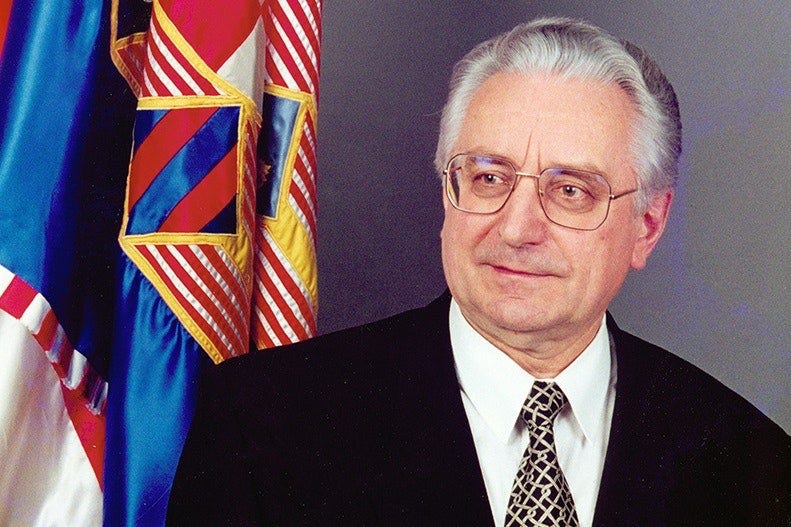July 1992.
An airlift for international humanitarian aid has been established over Sarajevo, amid the ambiguities of the Western powers [you can listen to the latest episode of BarBalkans - Podcast here].
Despite the divisions that are beginning to emerge between Bosniaks and Croats of Bosnia, the joint forces penetrate in the Dalmatian hinterland and liberate the city of Mostar.
However, also thanks to a series of - apparently - inexplicable decisions by Franjo Tuđman’s Croatia, in the rest of the Republic the military situation is favorable to Bosnian Serbs’ forces.
Here, a planned ethnic cleansing is being carried out against the civilian population, guilty of belonging to the ‘wrong’ ethnic group.
The death camps in Bosnia
From a public opinion perspective, July is a disaster for Belgrade.
At the Conference on Security and Cooperation in Europe (CSCE) summit in Helsinki, Slobodan Milošević’ regime suffers a diplomatic snub: the Foreign Minister of Russia, Andrei Kozyrev, condemns the war in Bosnia.
Moscow aligns with Washington in particular after a sniper attack on a bus of Bosnian orphans headed to Munich, just outside Sarajevo. A one-year-old boy and a two-year-old girl are killed.
But, in August, the international public opinion is even more interested in the report by U.S. journalist Roy Gutman, correspondent for Newsday, on Serbs’ concentration camps in occupied territories in Bosnia and Herzegovina.
The Bosnian President, Alija Izetbegović, has already denounced the existence of these camps in a letter to the U.S. President, George H. W. Bush. But he cannot have clear proof, due to inaccessibility of those areas by the authorities of the Republic of Bosnia and Herzegovina.
But in nearly a month of investigative work, Gutman manages to draw a map and to estimate the number of internees in Serbian prison camps in Bosnia, documenting the hell beyond the gates and the barbed wire.
People interned are 400 thousand, dead or alive. All civilians, the vast majority ethnic Muslims.
This is the size of how many Bosnians passed through the 94 concentration camps set up in barracks, schools, stadiums, even mines and industrial plants.
In the heart of Europe - 50 years after the Nazi Holocaust - history of extermination camps repeats itself, with a specific unwelcome, hated, enemy component of society being eliminated.
The most sadly famous camp is in Omarska, north of Banja Luka. Here, at least 5 thousand out of 13 thousand people have been killed before the publication of the journalistic investigation, that opens the Pandora’s box of ethnic cleansing put in place by Radovan Karadžić’ Bosnian Serbs.
The President of the Serbian Republic of Bosnia and Herzegovina is accused of genocide even by Belgrade (despite the fact that concentration camps are also located in Serbia and Montenegro).
Trying to prove the falsity of allegations, Karadžić allows British broadcaster ITN to film the Omarska camp and The Guardian journalist, Ed Vulliamy, to visit it.
The effect will be the opposite, with the international public opinion shocked to see again skeletal women and men behind barbed wire fences.
An article by Independent on Sunday explains:
«The horrific images of Bosnian prisoners, some with protruding ribs and stick-thin arms, had an impact on people in Western Europe and the United States that a year of assassinations, carried out by snipers and mortar bombs, failed to achieve».
A new fracture
Meanwhile, the situation in the Republic continues to worsen, partly because of the new fracture opened between Bosniaks and Croats of Bosnia.
On July 3, a high-level meeting of the Croatian Democratic Union of Bosnia (HDZ) is held in Grude, the same town where the Croatian Republic of Herzeg-Bosnia was proclaimed in November 1991.
Here, HDZ leader, Mate Boban, announces the establishment of a provisional executive power based in Mostar - the city just liberated from the Bosnian Serb siege - to buffer the collapse of the State administration.
This decision makes relations with Sarajevo increasingly tense and triggers the first serious clashes between the Croatian Defense Council and the Bosnian army, where the joint offensive has succeeded against Ratko Mladić’ Bosnian Serb army.
Even a meeting in Medjugorje between the two ethnic political leadership fails to restore mutual trust.
Pressed by international public opinion, the Croatian President, Franjo Tuđman - who is the reference point and grand puppetmaster of the most extremist Croats of Bosnia - signs a Treaty of Friendship and Cooperation in Zagreb with his Bosnian counterpart Izetbegović on July 21.
They decide on joint military efforts between the two Republics (Zagreb will support the Croatian Defense Council) against the Bosnian-Serb forces, if international diplomatic action will be unsuccessful.
Tuđman builds on the recent successes of his army, which on July 7 broke the Serbian siege of the Dalmatian city of Dubrovnik, after almost a year earlier.
But the willingness of the Croatian President to cooperate actively in the defense and the territorial integrity of Bosnia and Herzegovina is pure illusion.
All introductory podcasts are on Spreaker, Spotify, Apple Podcast and Google Podcast.
If you know someone who can be interested in this newsletter, why not give them a gift subscription?
Here is the archive of BarBalkans - Podcast:
And here the summary of 1991.

















Share this post